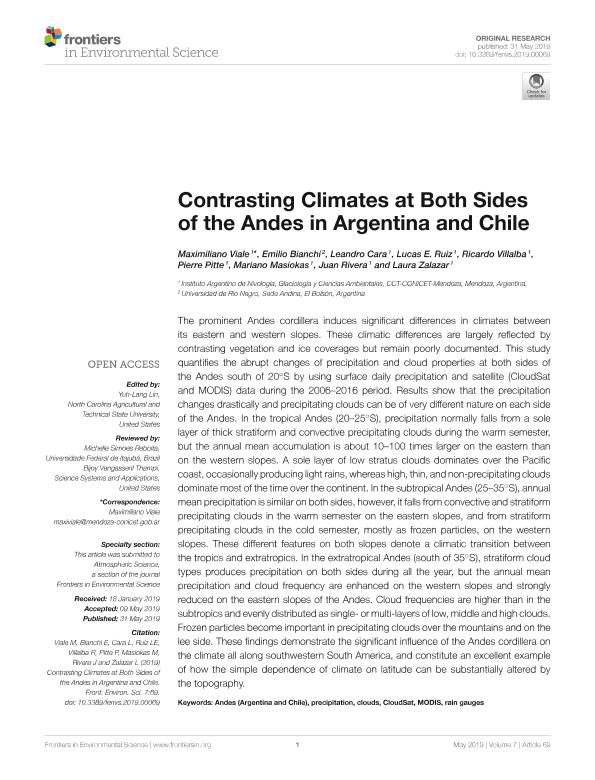Artículo
Contrasting climates at both sides of the Andes in Argentina and Chile
Viale, Maximiliano ; Bianchi, Emilio
; Bianchi, Emilio ; Cara Ramirez, Leandro Javier
; Cara Ramirez, Leandro Javier ; Ruiz, Lucas Ernesto
; Ruiz, Lucas Ernesto ; Villalba, Ricardo
; Villalba, Ricardo ; Pitte, Pedro Miguel
; Pitte, Pedro Miguel ; Masiokas, Mariano Hugo
; Masiokas, Mariano Hugo ; Rivera, Juan Antonio
; Rivera, Juan Antonio ; Zalazar, Laura Viviana
; Zalazar, Laura Viviana
 ; Bianchi, Emilio
; Bianchi, Emilio ; Cara Ramirez, Leandro Javier
; Cara Ramirez, Leandro Javier ; Ruiz, Lucas Ernesto
; Ruiz, Lucas Ernesto ; Villalba, Ricardo
; Villalba, Ricardo ; Pitte, Pedro Miguel
; Pitte, Pedro Miguel ; Masiokas, Mariano Hugo
; Masiokas, Mariano Hugo ; Rivera, Juan Antonio
; Rivera, Juan Antonio ; Zalazar, Laura Viviana
; Zalazar, Laura Viviana
Fecha de publicación:
05/2019
Editorial:
Frontiers Media S.A.
Revista:
Frontiers in Environmental Science
ISSN:
2296-665X
e-ISSN:
2296-6463
Idioma:
Inglés
Tipo de recurso:
Artículo publicado
Clasificación temática:
Resumen
The prominent Andes cordillera induces significant differences in climates between its eastern and western slopes. These climatic differences are largely reflected by contrasting vegetation and ice coverages but remain poorly documented. This study quantifies the abrupt changes of precipitation and cloud properties at both sides of the Andes south of 20°S by using surface daily precipitation and satellite (CloudSat and MODIS) data during the 2006-2016 period. Results show that the precipitation changes drastically and precipitating clouds can be of very different nature on each side of the Andes. In the tropical Andes (20-25°S), precipitation normally falls from a sole layer of thick stratiform and convective precipitating clouds during the warm semester, but the annual mean accumulation is about 10-100 times larger on the eastern than on the western slopes. A sole layer of low stratus clouds dominates over the Pacific coast, occasionally producing light rains, whereas high, thin, and non-precipitating clouds dominate most of the time over the continent. In the subtropical Andes (25-35°S), annual mean precipitation is similar on both sides, however, it falls from convective and stratiform precipitating clouds in the warm semester on the eastern slopes, and from stratiform precipitating clouds in the cold semester, mostly as frozen particles, on the western slopes. These different features on both slopes denote a climatic transition between the tropics and extratropics. In the extratropical Andes (south of 35°S), stratiform cloud types produces precipitation on both sides during all the year, but the annual mean precipitation and cloud frequency are enhanced on the western slopes and strongly reduced on the eastern slopes of the Andes. Cloud frequencies are higher than in the subtropics and evenly distributed as single- or multi-layers of low, middle and high clouds. Frozen particles become important in precipitating clouds over the mountains and on the lee side. These findings demonstrate the significant influence of the Andes cordillera on the climate all along southwestern South America, and constitute an excellent example of how the simple dependence of climate on latitude can be substantially altered by the topography.
Palabras clave:
ANDES (ARGENTINA AND CHILE)
,
CLOUDS
,
CLOUDSAT
,
MODIS
,
PRECIPITATION
,
RAIN GAUGES
Archivos asociados
Licencia
Identificadores
Colecciones
Articulos(IANIGLA)
Articulos de INST. ARG. DE NIVOLOGIA, GLACIOLOGIA Y CS. AMBIENT
Articulos de INST. ARG. DE NIVOLOGIA, GLACIOLOGIA Y CS. AMBIENT
Citación
Viale, Maximiliano; Bianchi, Emilio; Cara Ramirez, Leandro Javier; Ruiz, Lucas Ernesto; Villalba, Ricardo; et al.; Contrasting climates at both sides of the Andes in Argentina and Chile; Frontiers Media S.A.; Frontiers in Environmental Science; 7; 5-2019; 1-15
Compartir
Altmétricas



